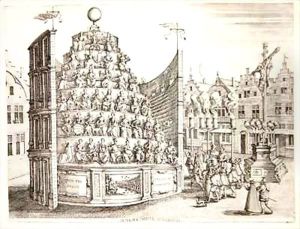Pieter van der Borcht Paintings
Pieter van der Borcht was a Flemish printmaker, draftsman, and painter, born around 1545 in Mechelen, which is now in modern-day Belgium. His work is characterized by its intricate detail and often whimsical subject matter. Van der Borcht was part of the Northern Renaissance, a period where art in the North of Europe flourished in its own right, distinct from the Italian Renaissance.
Initially, van der Borcht was trained by his father, Pieter van der Borcht the Elder, who was also an artist. He became a master in the Guild of St. Luke in Mechelen in 1566. His early work was influenced by another Flemish artist, Pieter Bruegel the Elder, known for his landscapes and depictions of peasant life. Van der Borcht developed a similar interest in detailed genre scenes and worked on both religious and secular subjects.
During his career, van der Borcht was highly regarded for his copperplate engravings. He was employed by the prominent publisher Christophe Plantin, contributing prints to illustrated books. His engravings were notable for their fine lines and attention to detail, and they were widely disseminated throughout Europe, contributing to his fame.
In addition to his prints, van der Borcht also produced a number of drawings and paintings, although these are less well-documented than his engravings. His drawings often served as models for prints and were sometimes collected in their own right. He was innovative in his use of the medium, experimenting with various techniques and materials.
Van der Borcht's work reflects the transition from the highly religious art of the medieval period to the more secular and humanist focus of the Renaissance. His legacy includes not only his own artworks but also his influence on other artists of his time and those who followed. He is considered an important figure in the history of Flemish printmaking. Pieter van der Borcht died in 1608, leaving behind a body of work that continues to be studied and appreciated for its contribution to the art of the Northern Renaissance.
